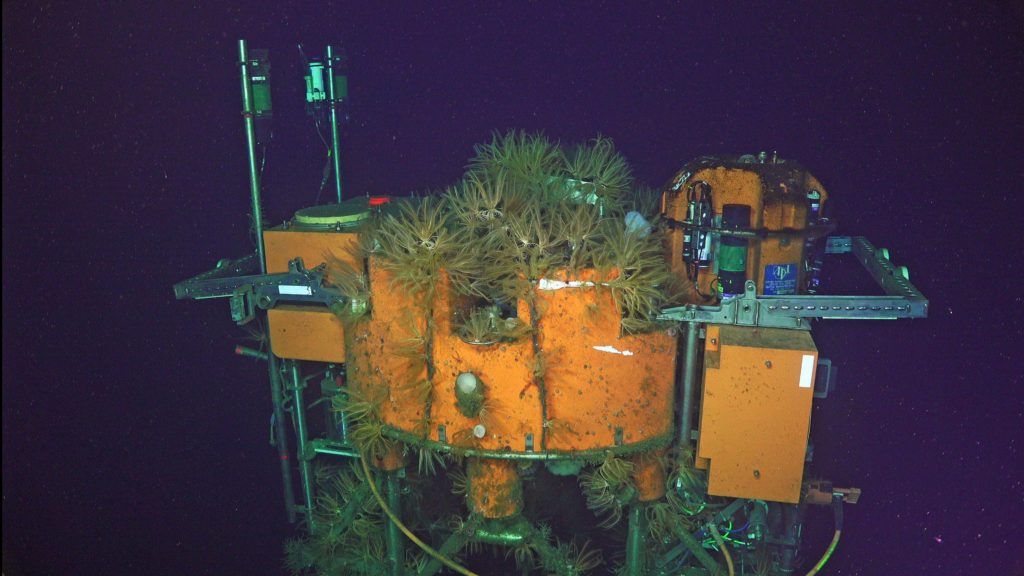August 17, 2023

It feels like ages since we left Newport, but we are just starting DAY 4! How can that be? The weather gods have continued to play games with us, making this Leg a chess match of where to work when, what platforms and instruments can we safely put down, and playing deck checkers as the engineers and ship crew move our equipment around on the fantail so that it can be accessed by Jason as our plans change hourly to daily. With continual changing conditions, it is hard to get into our normal at-sea rhythm.
The RCA team always works hard, but this cruise is “special” as we respond to ever changing seastate and last night very strong currents, making it unsafe to dive. Folks grab sleep when they can, stand watches for those who have been up a long time, and all are helping each other. However, this is life at sea, and we love it.
Even with these challenges, we are getting a lot of work done. On the 14th, following a dive at the Oregon Shelf site, we transited to the Oregon Offshore site to turn the Platform Interface Assembly (PIA) and winched Science Pod on the Shallow Profiler Mooring. It hosts a 12 ft across, 7,000 lb platform at 200 m (656 ft) water depth. In total, the PIA and Science Pod host 15 instruments, including ones that measure pH and carbon dioxide concentrations, important measurements for understanding ocean acidification in these biologically-rich waters.
The sea conditions were a bit rough so we got a special treat – two hours in the water with Jason to explore the mooring in detail as we waited for the seas to calm a bit so we could recover the PIA. The platform has turned into a beautiful island, engulfed in nutrient-rich currents that support an amazing assemblage of animals, which have colonized the platform since reinstalled in 2018. We spent the time mesmerized by both the abundance and diversity – captured with the 4K camera on Jason.

The 12 ft-across platform is covered in very large feather stars, interspersed with very healthy white and light orange anemones. The feather seastars are one of a very old phyla, around before starfish. They have two sets of legs, one set they use to hang onto substrate, and their tall “feathers” to funnel food into their mouths. Their feeding behavior is similar to sparse feather duster worms that dot the platform. One of our favorite animals on the mooring are strikingly beautiful nudibranchs (translates to naked gill), which unlike other snails, do not host shells. These are surprisingly abundant. They are delicate creatures that come in a variety of shapes and colors, hanging out on the platform and in the hydroids that form branching growths. Numerous clusters of light pink nudibranch eggs are on the feather stars. Huge numbers of translucent small shells shaped like scallops cover the top of the platform, and squat lobsters peak out from behind the instruments and feather stars. Baby sable fish were also swimming at the top of the mooring.

The closer we looked the more we saw. The multiple years of imaging these ‘islands’ provides a time series for colonization of what was once a completely clean surface. Documenting the development of this amazing ecosystem will be a fabulous project for the VISIONS’23 students.
Once we finished turning of the PIA and Science pod, the digital still camera was turned – Jason was visited by herds of sablefish. During the dive, weather came up with seastate too poor to turn the Benthic Experiment Platform. The decision was made to transit ~3 hrs yesterday afternoon (August 16th) to the Slope Base site to conduct a CTD sampling cast to 2900 m to collect water samples for follow-on instrument verification, to turn the PIA on the Shallow Profiler Mooring, and turn a low power junction box (LJ01A). Almost every year, we are visited by the “weird fish” at the junction boxes so we always look forward, especially, to this deep dive (9500 ft). During the transit we saw whales and then dolphins, which were playing in the waves.
The weather and currents again played with us in the early hours of the morning as Jason was conducting Dive J2-1520 to recover the PIA on the platform. The currents were extremely strong, making it very difficult for Jason hold station, so after recovery with the PIA, operations were on a weather hold for a few hours. Jason was able to dive again, however, with the successful installation of the PIA and Science Pod, and Dive J2-1522 is now underway to install the Science Pod…onward we go.

